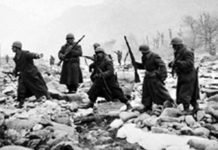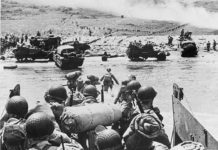North and South Korea were assured of a future apart with the Korean War of sixty years ago. A number of nations became involved, including New Zealand.
Divided Korea was a construction of World War II and the determination of both the USA and Soviet Union to have a stake in the strategically located peninsula. Division was not what the Koreans wanted, but the international mandate was for a superpower balance as geopolitics changed markedly in the immediate post-war years. By the end of 1945 the former allies had effectively divided the Korean peninsula arbitrarily between East and West, along the 38th parallel.
Under the auspices of the newly formed United Nations, attempts followed at creating a unified Korean government. When that failed the Soviet Union declared a Democratic Peoples’ Republic of Korea in the north, and the USA responded by establishing the Republic of Korea in the south. That was in 1948. Two years later on 25 June 1950, the Soviet-backed DPRK launched a surprise invasion of the ROK.
In response to the invasion the UN (with the Soviet Union absent), called on its members to help defend South Korea. A coalition of 21 nations answered the call,15 of them militarily joining the USA, which took overall command.
The Royal New Zealand Navy in Korea
New Zealand’s immediate contribution to hostilities was the deployment of the frigates HMNZS Pukaki and Tutira, later followed by Rotoiti, Hawea and Kaniere on a rotational basis. In the early stages of the war, the Royal New Zealand Navy frigates provided escort support for supply vessels moving between the main UN bases in Japan and the Korean peninsular as the US-led forces strived urgently to provide resistance to the DPKR advance.
By the end of July 1950 the North Koreans had control of most of the peninsula. The US Army and its allies were pushed back, forced to make a ‘last-ditch’ stand in the southeast corner of the peninsula, from what became known as the Pusan perimeter. Fierce fighting took place as more troops and equipment steadily arrived from Japan under escort. The decisive counter-strike however came elsewhere. Commander-in-Chief General McArthur’s plan was for an amphibious invasion on the other side of the Korean peninsula at Inchon, where he intended to cut off the North Korean supply lines.
On 15 September 1950 Operation Chromite was launched on Inchon. Pukaki and Tutira were part of a fleet that first escorted the troopships close into shore for the invasion, and then stood back to provide a protective screen some 40 km to seaward. The following month both vessels would play a similar role on the other side of the peninsular at Wonsan.
The roles of the RNZN ships would later escalate to include many diverse tasks. These included doing minesweeping duty, bombarding onshore installations, conducting inshore patrols, assisting landing parties and providing medical support.
The success of the Inchon invasion coordinated with a push north from Pusan saw the North Koreans forced back north of the 38th parallel. McArthur in fact convinced the UN that his armies should keep going. Some troops reached as far as the Chinese border, but not for long. The decision to launch a counter-invasion prompted China to join the conflict, and the impact of its forces had McArthur’s troops in retreat once more.
Kayforce Action in Korea
Kayforce was New Zealand’s ground force contribution to the Korean War. It’s deployment had been committed at the start of the conflict in July. But with recruitment, training and travel requirements, Kayforce did not join the action until January 1951. By then the Chinese troops had advanced to south of Seoul. The Kiwis provided an artillery regiment that joined the 27th British Commonwealth Infantry Brigade on 21 January 1951. They were immediately called into in action.
As the war dragged on and a stalemate developed, Kayforce was kept busy with actions on a number of fronts. In July 1951 it became part of the newly-formed 1st Commonwealth Division under the command of a British general.
The original 1,056-strong regiment was expanded with the addition of a transport company and signallers, who had an eventful journey to Korea after being shipwrecked on the way and eventually being flown from Australia to Japan. There were also a number of New Zealanders engaged with British and Australian Divisions, with which they had done their training.
On 27 July 1953 an armistice was signed between the two sides. However that did not mean peace, and New Zealanders stayed on duty in Korea for another four years before Kayforce’s last members came home. In total 3.794 army and 1,300 navy personnel from New Zealand served in Korea. Thirty three of them were killed in action.
A peace agreement has never been signed between the ROC and DPRK, and the Korean peninsula constantly remains a potential flashpoint. New Zealand is one of 16 countries involved in upholding the armistice agreement and has four NZ Defence Force officers stationed there.
References:
- Hopkins, G. F., Tales From Korea, The Royal New Zealand Navy in the Korean War, Reed, Auckland, 2002
- Rees, D., The Korean War, History and Tactics, Orbis, London, 1984








